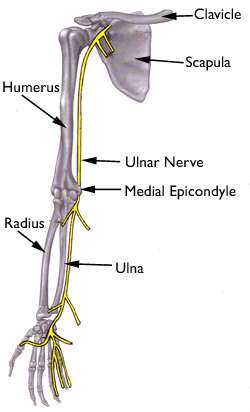
As a practicing orthopedic surgeon, I treat many types of nerve compression syndromes. The most common nerve compression syndrome of the upper extremity is Carpal Tunnel Syndrome. The second most common nerve compression neuropathy of the upper extremity is Cubital Tunnel Syndrome. Many people have never heard of Cubital Tunnel Syndrome and this article will definitely illuminate this subject area.
So, what is Cubital Tunnel Syndrome? This is compression of the ulnar nerve along the medial (inside) aspect of the elbow. Patients with this condition complain of numbness and tingling in the small finger, part of the ring finger and the back (dorsal) area of the hand near the small finger.
I often treat this condition in patients who have repetitive occupational duties or athletic regimens which require repetitive elbow flexion activities with a valgus stress across the elbow. This problem is also associated with increased bone growth on the medial aspect of the elbow, an unhealed fracture of the medial epicondyle, a tumor (mass), or even arthritis or post-traumatic changes at the elbow. There are also anatomic sites of ulnar nerve compression such as the medial head of the triceps, Osborne’s ligament, the Arcade of Struthers and several others anatomic sites.
There are many provocative and standard physical exam tests which are performed to diagnose Cubital Tunnel Syndrome. These include the elbow hypertension test and the ulnar nerve direct compression test. Electrodiagnostics tests such as an EMG/NVC can also be done to evaluate the severity of the ulnar nerve compression and function.
As a clinician, I perform tests on the patient to evaluate the function of the ulnar nerve or induced weakness from ulnar nerve dysfunction. If any of the tests are positive such as Wattenberg’s sign, Froment’s sign or Masse’s sign, then further evaluation is warranted.
There are several treatment protocols used for Cubital Tunnel Syndrome. I will review with you my directed treatment plans which are focused on avoiding surgery, if at all possible. As a holistic, integrated surgeon, I invoke many treatments which marry Eastern and Western medicine. The synergy of both types of medicine can optimize patient health.
Initial treatments include changes in work or athletic repetitive movements, ergonomic evaluations of work/ home office spaces, splinting, physical therapy and possibly anti-inflammatory medication.
If the earlier stated treatments are not effective, acupuncture is then used. This ancient and effective art is often beneficial in relieving the numbness and tingling symptoms experienced by many of my patients.
Surgery is the last option to be explored when all other non-operative modalities have not been effective. The surgical procedures involve decompressing the nerve. This means releasing the sites of ulnar nerve compression or releasing and moving the nerve which is an “in-situ transposition”.
Surgery is often very beneficial. This should be done as the last option of treatment even though the Cubital Tunnel Surgery is effective, it can recur. The recurrence rate for Cubital Tunnel Syndrome after surgery is higher than carpal tunnel release surgery.
I have presented the basics of Cubital Tunnel Syndrome which should help you in your discussion of treatment protocols with your health care provider. Remember, it is important to work as a team with your doctor or health-care givers. There can often be greater productivity when working as a team with your doctor.
Peace & Health
Dr. Levi Harrison
“What is Cubital Tunnel Syndrome?”copyright © May 27, 2014 by D. Levi Harrison, MD



Thank you.My husband diagnosed with bilateral carpal & cubital in left elbow.Saw 2 surgeons & both do not seem as open to conservative treatment.Are you taking new patients at this time?Is there someone in your office who would have time to answer some ?s over the phone?Thank you
Hi Jill, Dr. Harrison is certainly taking new patients. Please call : (818) 240-8001 and hopefully we can answer any questions you may have. Take care!
I have retired, my pass job consist of lots of typing, my wrist hurt and pain shots up my arm. Also having trouble with my rotator Culp, I would like exercises to help make wrist and arms stronger, and alleviate pain in arms. I am now in therapy 2 days a week. for my rotator culp pain.